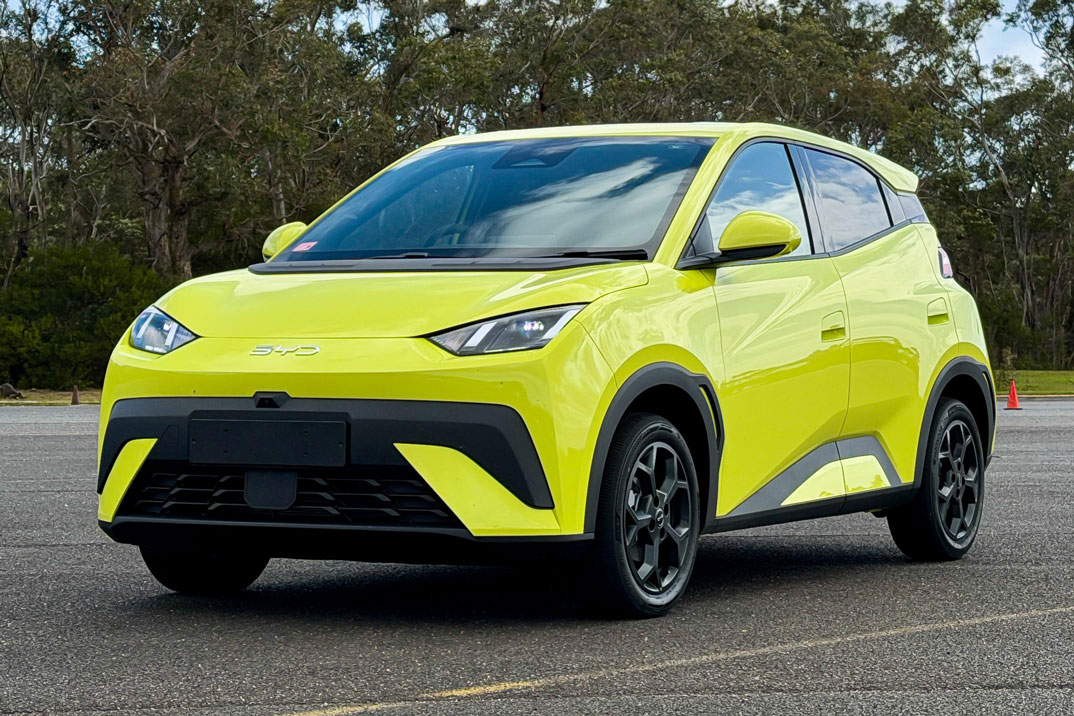
The Australian electric vehicle market is on the cusp of a seismic shift, driven by a relentless pursuit of affordability. For years, the high price of entry was the single largest barrier to mass EV adoption. That barrier was first significantly cracked by the BYD Dolphin, but the true dismantling of the price wall is now imminent.
The current title-holder for Australia’s most affordable electric vehicle is the BYD Dolphin Essential, a surprisingly capable small hatchback that starts from $29,990 plus on-road costs. The Dolphin’s arrival ushered in the sub-$30,000 EV era, proving that electric motoring was no longer exclusively the domain of luxury buyers or early adopters. It democratised the segment, moving EVs from a niche curiosity to a viable, everyday transport solution for many Australians.
However, the Dolphin’s reign as the price leader is set to be short-lived. A future rival, arriving from within the same dynamic Chinese automaker, BYD, promises to reset the market once more: the diminutive but hugely significant BYD Atto 1. With a confirmed Australian launch set for November 2025, the Atto 1 is expected to slice the entry price down further, with market estimates and company hints pointing to a starting price of around $25,000 before on-road costs. This single price point is not merely a new low for EVs; it is a declaration of war on the established, entry-level petrol car market, and the long-awaited turning point for mass EV uptake.
The New Price Champion: Meet the BYD Atto 1 (Seagull)
Known as the Seagull in its massive home market of China, and occasionally the Dolphin Surf in European discussions, the Atto 1 represents the purest expression yet of BYD’s mission to make electric mobility accessible to all. Globally, the Seagull has been a phenomenon, with over a million units sold since its 2023 debut, demonstrating that demand for an ultra-affordable, no-nonsense city EV is immense.
For Australia, BYD has confirmed the vehicle will land with the name Atto 1, positioning it below the existing Atto 3 and the soon-to-arrive Atto 2 in the local lineup. The promise from BYD Australia chief operating officer Stephen Collins is unambiguous: the Atto 1 “will be Australia’s most affordable EV by some margin.” Given the Dolphin is the current cheapest at $29,990, an estimated price of $25,000 or less places the Atto 1 in a different league entirely, undercutting its stablemate by thousands and creating a crucial price gap to prevent internal sales cannibalisation.
This aggressive pricing strategy directly challenges the financial viability of equivalent internal combustion engine (ICE) light hatchbacks. At a projected $25,000 before on-roads, the Atto 1 effectively becomes price-competitive with base-spec petrol rivals like the Toyota Yaris and Mazda 2, cars that traditionally rely on their low sticker price to attract first-time buyers and city commuters. When factoring in the significantly lower running costs, maintenance, and government incentives associated with electric ownership, the Atto 1 begins to look not just competitive, but overwhelmingly superior as a value proposition.
Form Factor and Function: A Dedicated City Car
The Atto 1 is built for the urban environment. Measuring just 3,990mm long and 1,720mm wide, its dimensions place it squarely in the light-car segment, making it perfectly suited for tight city parking and congested streets. Its compact size is paired with a clever, boxy design that maximises interior volume, adhering to the principle that a city car should be easy to park but spacious inside.
Despite its entry-level price, the Atto 1 benefits from BYD’s latest electric vehicle architecture, the renowned e-Platform 3.0, and leverages the company’s proprietary, safer, and cheaper Blade Battery technology (Lithium Iron Phosphate or LFP).
Local specifications for the Australian market are expected to mirror a dual-variant structure:
- Atto 1 Essential: The entry point. It is powered by a 30 kWh Blade Battery paired with a front-mounted electric motor delivering 65 kW of power and 175 Nm of torque. This combination provides an estimated 220 km of WLTP driving range. Designed purely for city and short-haul commuters, this range is more than sufficient for daily tasks, requiring an owner with access to convenient home or workplace charging.
- Atto 1 Premium: For drivers needing greater flexibility. This variant upgrades to a larger 43.2 kWh Blade Battery and a more potent motor offering 115 kW and 220 Nm. Crucially, the range extends to a more comfortable 310 km (WLTP). The Premium model is also expected to feature faster DC charging (up to 85 kW, compared to the Essential’s 65 kW) and the increasingly sought-after Vehicle-to-Load (V2L) functionality, allowing owners to power external devices or appliances from the car’s battery.
Both variants deliver reasonable performance for city life, with the Essential hitting 0-100 km/h in 11.1 seconds, and the Premium trimming that sprint down to a zippier 9.1 seconds—a time quicker than many petrol competitors.
Technology and Safety: No Compromise on Modern Features
In a true sign of BYD’s global commitment to value, the Atto 1 does not skimp on interior technology. Unlike some budget micro-cars, the Atto 1 cabin is far from spartan. It features a modern, clean design anchored by a 7-inch digital instrument cluster and, most distinctively, a large 10.1-inch rotating infotainment touchscreen. This feature, a hallmark of the BYD brand, manages all key functions, including navigation, media, and climate control, and comes equipped with staples like Apple CarPlay, Android Auto, and over-the-air (OTA) software update capability. Higher-spec models are even slated to include a 360-degree camera system and wireless smartphone charging.
Safety has been a key area of scrutiny for Chinese-built vehicles, but BYD has shown a dedication to high standards. While local crash testing results (ANCAP) are pending, the Atto 1 will arrive with a comprehensive suite of active and passive safety features, including multiple airbags and BYD’s integrated suite of advanced driver assistance systems (ADAS). The vehicle is strictly a four-seater, a design choice that optimises space and comfort for four occupants while maintaining the compact exterior dimensions.
Backing up the product is a robust after-sales commitment, with BYD offering a six-year/150,000km vehicle warranty and an eight-year/160,000km warranty on the high-voltage Blade Battery, providing peace of mind for budget-conscious buyers new to EV ownership.
The Tipping Point for Australian EV Adoption
The arrival of the BYD Atto 1 in November 2025 is more than a new model launch; it marks a watershed moment for Australia’s transition to electric mobility. The current $29,990 Dolphin established the $30,000 threshold, but the $25,000 Atto 1 is the vehicle that will truly popularise the category.
By positioning an electric car directly against the cheapest mainstream petrol options, BYD is removing the last significant financial excuse for delaying the shift to electric. It makes the conversation no longer about ‘if’ an EV can be afforded, but ‘which’ BYD model best fits the budget—the compact Atto 1, the slightly larger Dolphin, or the popular Atto 3 SUV.
The Atto 1 is set to be the catalyst for the next wave of Australian EV adoption, targeting the millions of city-dwellers, young professionals, and two-car families who need an efficient, practical, and, most importantly, affordable commuter. As BYD continues its aggressive expansion in the Australian market—with the Atto 1 launching alongside the new Atto 2 SUV and a suite of Sealion plug-in hybrid vehicles (PHEVs) confirmed for early 2026—the market dominance of the Chinese giant is only set to accelerate. The race to the bottom on price is proving to be the race to the top of the sales charts, and with the $25,000 Atto 1, BYD is cementing its position as the brand that made electric motoring a reality for every Australian.
FAQs
When will the BYD Atto 1 arrive in Australia?
BYD has confirmed an Australian launch for November 2025. Exact availability and allocation to dealers will be announced closer to launch, and prospective buyers should check local dealer lists for reservation and delivery timelines.
How much will the Atto 1 cost in Australia?
Industry reports and BYD statements indicate a target starting price around $25,000 before on‑road costs, though final local pricing will be confirmed by BYD Australia at launch. State incentives, on‑road costs and dealer offers will affect the out‑the‑door price.
What range can buyers expect from the Atto 1?
WLTP figures suggest about 220 km for the 30 kWh Essential and around 310 km for the 43.2 kWh Premium. Real‑world range will vary with driving style, climate, speeds and accessory use – urban driving typically yields better practical range than sustained highway driving.
Is the Atto 1 suitable as a family’s only car?
For many urban households, the Atto 1 will be an ideal runabout for daily commuting and errands. Households that routinely undertake long intercity trips may find the smaller battery less convenient unless they plan frequent rapid DC charging stops or opt for the larger Premium variant.
How does ownership cost compare with petrol rivals?
Electric vehicles tend to have lower per‑kilometre energy costs and reduced scheduled maintenance. When factoring in potential state incentives and lower running costs, an Atto 1 can present a compelling total cost of ownership compared to similarly priced petrol hatchbacks, though personal driving patterns and access to charging will affect the outcome.
About EV Evolution
EV Evolution is the leading online platform dedicated to Australian electric vehicle owners and enthusiasts. We foster a vibrant community, delivering essential EV news and insights, and enhancing user engagement through our innovative, AI-powered chatbot for dynamic discussions. Our mission is to empower Australian electric vehicle owners and enthusiasts by fostering a vibrant, AI-driven online community that connects, informs, and advances the nation’s electric vehicle landscape




